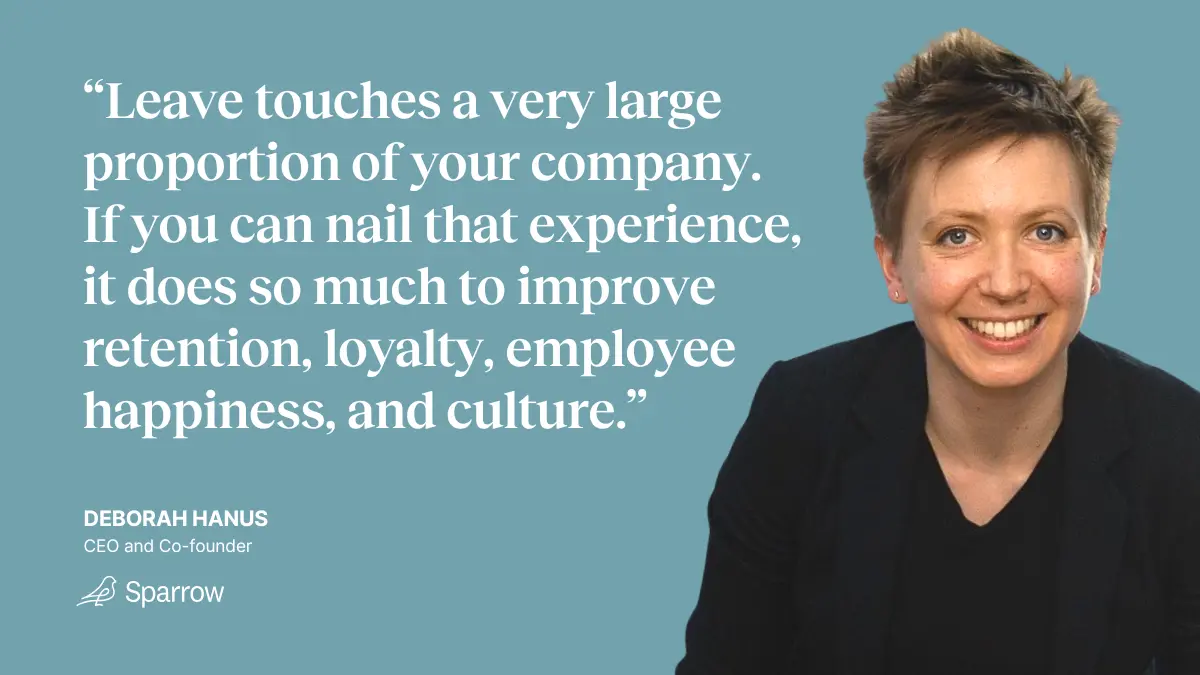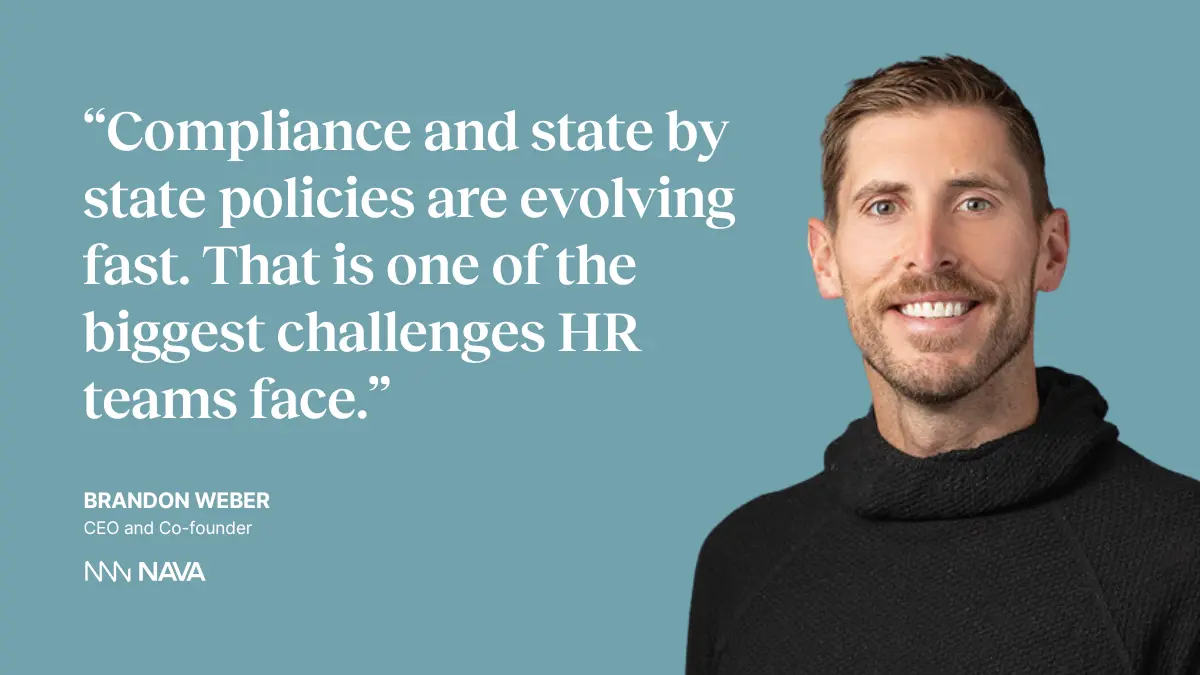The employer’s guide to leaves of absence: clarity, compassion, and compliance

A leave of absence can be one of the most important moments in an employee’s life, and the way an employer handles it can shape trust, culture, and retention. This guide explains how to build a leave process rooted in clarity, compassion, and compliance, with real insights from experts in HR, legal, and leave management.
Employee leave is one of the most critical parts of the workplace experience. It’s also one of the most misunderstood. Each year, roughly 10 percent of an employer’s workforce goes out on leave, according to Cocoon CEO Deborah Hanus. For a mid-sized company, that translates into thousands of hours of administrative work, countless moments of employee vulnerability, and a growing list of compliance obligations that shift from state to state.
To help HR teams make sense of this complexity, Nava recently hosted a webinar featuring three leading experts in the field: Deborah Hanus, CEO and Co-founder of Cocoon, Brandon Weber, CEO of Nava Benefits, and Michelle Barrett Falconer, Partner at Littler Mendelson and nationally recognized leave and compliance attorney
Together, they explored the real-world challenges employees and HR teams face during a leave of absence, the legal and administrative risks employers often underestimate, and the practical steps organizations can take to build a more supportive, compliant leave experience.
This guide distills the key insights from that conversation. We break down what a leave of absence really is, why it matters, the biggest challenges HR teams are navigating, and how employers can create a leave program that is simple, supportive, and aligned across every stakeholder.

What is a leave of absence?
A leave of absence is an approved period of time that an employee takes away from work for personal, medical, or family reasons. Leaves can be paid or unpaid, job protected or unprotected, and governed by federal laws, state programs, company policies, or all three at once.
This is where things get complicated. Employers are often juggling the Family and Medical Leave Act (FMLA), Americans with Disabilities Act (ADA) considerations, and a growing number of state paid family and medical leave programs. These programs do not always align, which makes consistency and clarity difficult.
This is why clear definitions and accessible policies matter. When employees understand what leave is available to them and what they need to do next, it reduces confusion and builds trust.

Why employee leave matters more than ever
Leave is not simply a legal requirement or benefit. It’s a core driver of the employee experience and a meaningful contributor to company culture.
When employees take leave, they’re often navigating major moments such as childbirth, caregiving, illness, bereavement, or mental health challenges. How an employer shows up in these moments sends a strong cultural signal.
Why it matters for employees
A well designed leave program helps employees feel supported rather than overwhelmed, leading to:
- Better physical and mental health outcomes
- Reduced financial stress
- Clearer expectations during vulnerable moments
- More confidence in their employer
Why it matters for employers
A strong leave program does more than meet legal requirements. It strengthens the entire organization by improving culture, retention, and risk management. When leave is handled well, employers benefit from:
- Stronger retention and loyalty
- Lower turnover costs
- A more supportive, inclusive culture
- Reduced legal risk
A positive leave experience doesn’t just benefit one person. It benefits the entire organization.

The most common challenges HR teams face with leave management
Managing leave has become one of the most time-consuming and high-stakes responsibilities on the HR agenda. It’s also one of the least visible.
Here are the major challenges we see HR leaders facing today:
1. Navigating complex laws and regulations
Policies vary by state and often conflict with one another. Employers need to determine which laws apply, whether leave is job protected, whether it’s paid or unpaid, and how benefits integrate during leave.

2. Heavy administrative burden
Coordinating leave involves HR, managers, payroll, benefits teams, and sometimes third-party vendors. That creates opportunities for miscommunication if processes aren’t documented and aligned.

3. Risk of miscommunication that harms employee experience
When employees are on leave, unclear messages, inconsistent expectations, or outdated information can create stress and harm trust.
4. Keeping everyone aligned
The more stakeholders involved, the easier it is for information to get out of sync. Deborah emphasized that ensuring everyone is working from the same, up-to-date information can eliminate the vast majority of leave related issues. When systems are scattered, leave management becomes even more complex.
Types of employee leave, explained
Employees take leave for a wide range of reasons, and most organizations offer a mix of legally required and company-provided options. Understanding the nuances behind each type of leave helps HR teams set clear expectations and ensure employees receive the support they need.
Below are the most common types of leave, along with examples of when they typically apply:
Medical leave
Employees use medical leave when they’re unable to work due to a serious health condition. This can include inpatient care, chronic conditions, or situations where ongoing treatment makes it difficult to perform essential job functions.
Examples:
- Recovering from major surgery
- Managing complications related to pregnancy
- Undergoing treatment for cancer or another chronic illness
This type of leave may be covered by FMLA, state medical leave programs, company sick leave, or short term disability.
Parental leave
Parental leave supports employees as they welcome a new child into their family. It can include a mix of federal, state, and company-provided benefits depending on location and employer policy.
Examples:
- Birth and recovery for birthing parents
- Bonding leave for non-birthing parents
- Leave for adoptive or foster parents
- Additional leave for complications before or after childbirth
As Deborah pointed out during the webinar, the number of non-birthing parents taking leave is rising fast, which means inclusive policies matter more than ever.
Family caregiving leave
Caregiving leave allows employees to step away from work to care for a family member dealing with a serious health condition. Many states define “family” more broadly than federal law, which can influence eligibility.
Examples:
- Caring for a spouse recovering from surgery
- Supporting a parent during chemotherapy
- Managing care for a child with a long term illness
This type of leave is often covered by FMLA and state-paid family leave programs.
Personal leave
Personal leave is used when an employee needs time away for non-medical or non-caregiving reasons that still significantly affect their life. Unlike medical or parental leave, personal leave is often at the employer’s discretion.
Examples:
- Relocating or handling a major housing transition
- Attending to legal matters
- Mental health needs that do not rise to the level of a formal medical leave
Strong personal leave policies can prevent employees from “trying to fit” their situation into the wrong type of leave.
Bereavement leave
Bereavement leave provides time and space to grieve and attend to logistical responsibilities after the death of a loved one.
Examples:
- Funeral planning and attendance
- Handling affairs or estates
- Traveling to support family members
- Taking personal time to grieve
Company policies vary widely, so clarity here is especially important.
Disability leave
Disability leave typically applies when an employee has a medical condition that prevents them from working for an extended period. It often involves insurance benefits, which come with specific timelines, documentation requirements, and eligibility rules.
Examples:
- Extended recovery after a traumatic injury
- Managing long term chronic conditions that require time away
- Complications from surgery that extend beyond typical medical leave
Disability leave may include short term disability, long term disability, or both.
Military leave
Military leave provides job protected time away for employees who serve in the armed forces, National Guard, or reserves. Under USERRA, eligible employees are entitled to leave for military duties and must be reinstated to their position upon return.
How a leave of absence works
Every employer should have a clearly documented leave process that explains what employees need to do and what they can expect. While every situation varies, a typical leave journey includes the following steps:
- Employee notifies their manager or HR
- HR determines eligibility under federal, state, or company programs
- Employee submits required paperwork or medical certifications
- HR or vendor approves or denies leave
- HR coordinates pay, benefits, and communications
- Employee goes on leave
- Return to work planning begins
- Reintegration after leave, including potential accommodations
This is a carefully choreographed process that requires coordination across multiple teams.
How employers can support employees while on leave
Employees often describe the leave experience as overwhelming, emotional, and deeply personal. Support during this period is less about policies and more about how employers show up. Rather than focusing on checklists, it helps to think in terms of guiding principles that shape the employee’s journey.
Here are a few ways employers can create a smoother, more human experience:
- Set expectations early so employees understand what will happen and when.
- Establish communication norms that balance clarity with respect for boundaries.
- Prepare managers so they know their role and can support transitions effectively.
- Ensure employees understand how their pay, benefits, and job protection will work.
- Begin return to work conversations before the leave ends, making reintegration feel safe and predictable.
In short, great support is proactive, not reactive. It makes the full experience feel coordinated rather than chaotic.
How to build a strong, clear leave policy
A leave policy is more than a document. It’s the blueprint for how your organization interprets the law, communicates expectations, and supports employees during pivotal moments. To be effective, it must balance legal accuracy with human clarity.
Instead of thinking about this as a list of required components, think about the questions your policy should answer:
What employees need to know:
- What types of leave are available?
- Who is eligible for each type?
- What happens to their pay and benefits during leave?
- How do they request time away, and what documentation is required?
What managers and HR need to know:
- How decisions are communicated
- How timelines and documentation are tracked
- What their responsibilities are during leave and upon return
- What a standard return-to-work process looks like
When these questions are answered clearly and consistently within one aligned policy, employees feel informed and confident, and the organization reduces risk from inconsistent handling.
Key takeaways
Leave is complex, emotional, and more common than most leaders realize. As Brandon Weber put it, “Everyone cares about this. The question is how to move the ball forward.”
Here are the essentials:
1. Leave is frequent and high impact.
A significant portion of your workforce takes leave each year, often during vulnerable moments.
2. Definitions matter.
Clear explanations of leave types reduce confusion for both employees and managers.
3. Compliance is complicated.
Overlapping federal and state laws require careful attention and consistent interpretation.
4. Communication drives the experience.
Most problems stem from misalignment or unclear expectations.
5. Policies should be simple and human centered.
Plain language and clear steps make the process feel manageable.
6. Reintegration is part of the journey.
Return-to-work support strengthens trust and retention.







